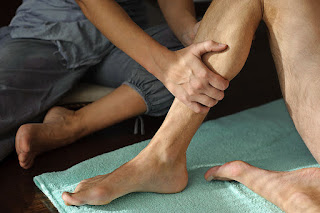Treating Osteoarthritis of the Knee
Treating osteoarthritis of the knee depends greatly on the stage of the condition. There are five stages of osteoarthritis ranging from no signs or symptoms to severe.
Stage 0 – This is a normal, healthy knee that needs no treatment.
Stage 1 – Predisposition to osteoarthritis
At this stage, you may be beginning to experience some early symptoms such as soreness or swelling after exercise and you most likely have a family history of osteoarthritis or have had surgery on your knee to move cartilage or the menisci which increases your risk or osteoarthritis. The focus of this stage of treatment is prevention, mainly in the form of strength and stability training of the knee and glucosamine supplements.
Stage 2 – MildStage
At this stage, you will begin to experience symptoms of osteoarthritis including pain after long periods of exercise, and stiffness and tenderness when bending or kneeling. Treatment for mild stage osteoarthritis includes:
• Low impact cardio including cycling, swimming and walking
• Strength and stability training to strengthen the knee and stabilize the joint
• Avoiding activities such as kneeling and jumping or squatting incorrectly (with knees forward of the toes) as this adds pressure to the joint
• Orthotics to relieve pressure on the knee when walking
• Taping to support the knee during exercise
Stage 3 – Moderate Stage
At this stage you have obvious cartilage damage to your knee and frequent pain and swelling, especially when exercising, bending or kneeling. You will find your knee joint is stiff after long periods of sitting or first thing in the morning. Treating this stage of osteoarthritis focuses on pain management and the use of cortisone injections and strong pain relief such as codeine or oxycodone. Rehabilitation exercises will be needed to help with range of motion of the knee and maintaining leg strength.
Stage 4 – Severe Stage
At this stage of osteoarthritis, you will be experiencing a great deal of pain and discomfort with any movement of your knee. There will be little to no cartilage left and your knee will be stiff and/or immobile. There will be a significant decrease in synovial fluid which increases friction, causing further pain and crepitus (grinding sound as you move your knee). At this stage, treatment focuses on surgery – either bone realignment or a full knee replacement.
iACHE.com is a platform that attempts to bridge a huge gap in the care of people suffering from chronic pain or addiction disorder. The management of these conditions requires integration between primary care providers, physical therapists, nutriologists, psychologists and specialists. Optimizing the communication between them, and giving you a platform to stay connected with them and other people with similar conditions, will empower those suffering from chronic pain to take control of their lives and have a n accessible resource everywhere they go.
Stage 0 – This is a normal, healthy knee that needs no treatment.
Stage 1 – Predisposition to osteoarthritis
At this stage, you may be beginning to experience some early symptoms such as soreness or swelling after exercise and you most likely have a family history of osteoarthritis or have had surgery on your knee to move cartilage or the menisci which increases your risk or osteoarthritis. The focus of this stage of treatment is prevention, mainly in the form of strength and stability training of the knee and glucosamine supplements.
Stage 2 – MildStage
At this stage, you will begin to experience symptoms of osteoarthritis including pain after long periods of exercise, and stiffness and tenderness when bending or kneeling. Treatment for mild stage osteoarthritis includes:
• Low impact cardio including cycling, swimming and walking
• Strength and stability training to strengthen the knee and stabilize the joint
• Avoiding activities such as kneeling and jumping or squatting incorrectly (with knees forward of the toes) as this adds pressure to the joint
• Orthotics to relieve pressure on the knee when walking
• Taping to support the knee during exercise
Stage 3 – Moderate Stage
At this stage you have obvious cartilage damage to your knee and frequent pain and swelling, especially when exercising, bending or kneeling. You will find your knee joint is stiff after long periods of sitting or first thing in the morning. Treating this stage of osteoarthritis focuses on pain management and the use of cortisone injections and strong pain relief such as codeine or oxycodone. Rehabilitation exercises will be needed to help with range of motion of the knee and maintaining leg strength.
Stage 4 – Severe Stage
At this stage of osteoarthritis, you will be experiencing a great deal of pain and discomfort with any movement of your knee. There will be little to no cartilage left and your knee will be stiff and/or immobile. There will be a significant decrease in synovial fluid which increases friction, causing further pain and crepitus (grinding sound as you move your knee). At this stage, treatment focuses on surgery – either bone realignment or a full knee replacement.
iACHE.com is a platform that attempts to bridge a huge gap in the care of people suffering from chronic pain or addiction disorder. The management of these conditions requires integration between primary care providers, physical therapists, nutriologists, psychologists and specialists. Optimizing the communication between them, and giving you a platform to stay connected with them and other people with similar conditions, will empower those suffering from chronic pain to take control of their lives and have a n accessible resource everywhere they go.




Comments
Post a Comment